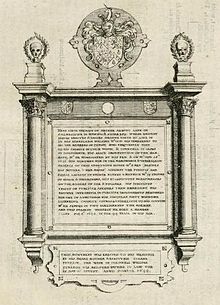George Abbot (author)
George Abbot or Abbott (1604 – 2 February 1649) was an English lay writer, known as "The Puritan", and a politician who sat in the House of Commons in two periods between 1640 and 1649.[1] He is known also for his part in defending Caldecote House against royalist forces in the early days of the English Civil War.[2]
Life[edit]
Abbott was the son of George Abbott of York (died 1607) and his wife Joan Penkeston. While Alumni Cantabrigienses states that he matriculated at King's College, Cambridge in 1622, the Oxford Dictionary of National Biography discounts the identification, for lack of evidence.[2][3] He owned property in Baddesley Clinton, Warwickshire, and was a good friend of Richard Vines, minister at Caldecote some way to the east.[4] In April 1640, he was elected as a Member of Parliament (MP) for Tamworth in the Short Parliament.[5]

In the English Civil War, Abbot worked closely in Warwickshire with his stepfather William Purefoy, and made a notable defence, with his mother Joan, of the Purefoy house at Caldecote, Warwickshire, gaining the family coverage in the London press.[6] On 15 August 1642, with eight men, his mother and maids, he held out for a time against Prince Rupert of the Rhine, with about 18 troops of horses and dragoons.[2] In the aftermath of the Battle of Edgehill, in October of the same year, Richard Baxter moved to Coventry, and Abbot was one of those hearing him preach there.[7] Baxter in writing on the Sabbath referred to "my dear friend Mr. George Abbot".[8] In his memoirs Reliquiæ Baxterianæ, Baxter placed Abbot's defence of Caldecote House, where barns were burnt, in local context: royalists under Spencer Compton, 2nd Earl of Northampton were attacking Warwick Castle, defended by John Bridges, and Coventry, defended by John Barker.[9]
Abbot was re-elected MP for Tamworth in 1645 for the Long Parliament and held the seat until his death in 1649.[10] He died unmarried in his 44th year, and was buried in Caldecote church where his monument describes his defence of Caldecote.[2]
Legacy[edit]
By his will, Abbot endowed a free school at Caldecote.[11] It was supported by land left to it at Baddesley Ensor.[12]
Works[edit]
Abbot was a lay theologian and scholar. His Whole Booke of Job Paraphrased, or made easy for any to understand (1640), was written in a terse style, and his Vindiciae Sabbathi (1641) influenced the Sabbatarian controversy.[13] His The Whole Book of Psalms Paraphrased (1650) was published posthumously by Richard Vines, and dedicated to Joan Purefoy, his mother.[14]
Mistaken identifications[edit]
Abbot has been confused with others of the same name and has been described as a clergyman, which he never was. His writings have been incorrectly attributed in some bibliographical authorities to a relation of George Abbot the archbishop of Canterbury. One of the sons of Sir Morris Abbot called George was also an MP in the Long Parliament but for the constituency of Guildford.[13]
Notes[edit]
- ^ He died on "Feb. 1648-9" see Dictionary of National Biography, Errata (1904), p. 1 in Grosart 1885, p. 23. This means he died 3 days after the execution of Charles I, which is usually recorded as having happened on 30 January 1649 not 1648 because at that time the new year was 25 March not 1 January (for a more detailed explanation see Old Style and New Style dates).
- ^ a b c d Roberts, Stephen K. "Abbott, George". Oxford Dictionary of National Biography (online ed.). Oxford University Press. doi:10.1093/ref:odnb/5. (Subscription or UK public library membership required.)
- ^ "Abbotts or Abbot, George (ABTS622G)". A Cambridge Alumni Database. University of Cambridge.
- ^ Ann Hughes (16 May 2002). Politics, Society and Civil War in Warwickshire, 1620-1660. Cambridge University Press. p. 175. ISBN 978-0-521-52015-7.
- ^ Willis 1750, p. 229, 236.
- ^ Hughes, Ann. "Purefoy, William". Oxford Dictionary of National Biography (online ed.). Oxford University Press. doi:10.1093/ref:odnb/22901. (Subscription or UK public library membership required.)
- ^ Richard Baxter; William Orme (1830). The Practical Works of the Rev. Richard Baxter: With a Life of the Author, and a Critical Examination of His Writings. J. Duncan. p. 42.
- ^ Richard Baxter (1838). The Practical Works of Richard Baxter: With a Preface, Giving Some Account of the Author, and of this Edition of His Practical Works : an Essay on His Genius, Works and Times : and a Portrait. G. Virtue. p. 879.
- ^ Richard Baxter (1696). Reliquiæ Baxterianæ: Or, Mr. Richard Baxter's Narrative of the Most Memorable Passages of His Life and Times. T. Parkhurst, J. Robinson, J. Lawrence, and J. Dunton. p. 29.
- ^ Willis 1750, pp. 240, 249.
- ^ Great Britain. Parliament. House of Commons (1835). Parliamentary Papers, House of Commons and Command. H.M. Stationery Office. p. 934.
- ^ Samuel Lewis (1840). A Topographical Dictionary of England, Comprising the Several Counties, Cities, Boroughs, Corporate and Market Towns, Parishes, and Townships, and the Islands of Guernsey, Jersey, and Man: With Historical and Statistical Descriptions. S. Lewis and Company. p. 412.
- ^ a b Chisholm 1911, p. 23.
- ^ W. C. Hazlitt. Second series of bibliographical collections and notes on early English literature, 1474-1700. Рипол Классик. p. 2. ISBN 978-1-176-44964-0.
References[edit]
- Chisholm, Hugh, ed. (1911). . Encyclopædia Britannica. Vol. 1 (11th ed.). Cambridge University Press. p. 23. Endnotes:
- MS.collections at Abbeyville for history of all of the name of Abbot, by J.T. Abbot, Esq., F.S.A., Darlington;
- William Dugdale, Antiquities of Warwickshire, 1730 p. 1099;
- Anthony à Wood, Athenae Oxonienses (Bliss), ii.141, 594;
- Cox, Literature of the Sabbath.
- Grosart, Alexander Balloch (1885). . In Stephen, Leslie (ed.). Dictionary of National Biography. Vol. 1. London: Smith, Elder & Co. pp. 20–21.
- Willis, Browne (1750). Notitia Parliamentaria, Part II: A Series or Lists of the Representatives in the several Parliaments held from the Reformation 1541, to the Restoration 1660 ... London. pp. 229, 236 240, 249.
